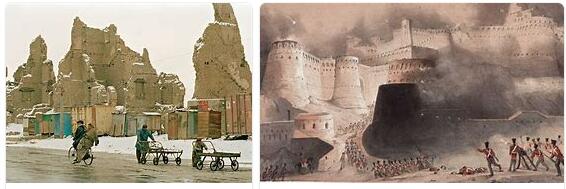Daud’s regime
The 17 of July of 1973 was overthrown the monarchy 40 years of Mohamed Zahid Shah. The then Prime Minister, Mohamed Daud, proclaimed the Republic and became President.
Socialist revolution and Soviet aid
In 1978, a Revolution, led by the People’s Democratic Party of Afghanistan (PDPA), overthrew Daud.
The USSR, in support of the Afghan government that was fighting against the counterrevolutionary groups armed and stimulated by the US and self-styled mujahideen (which means they wage “holy war” or jihad), sent its troops to Afghanistan. The Mujahideen guerilla, divided into various factions supported by different countries (the United States, Iran, Pakistan, Saudi Arabia) coincided with growing divisions in Kabul.
In May 1986, President Babrak Karmal was replaced as Secretary of the PDPA by Mohammed Najibullah, a young Pashtun doctor, who in January 1987 announced a unilateral ceasefire, accompanied by guarantees for opposition leaders who wanted to negotiate with the government, amnesty to the imprisoned insurgents and the promise of a prompt withdrawal of the Soviet troops. The mujahideen, however, continued the fight.
After six years of negotiations, an Afghan-Pakistani agreement was signed in Geneva, with the guarantee of the United States and the Soviet Union. This agreement guaranteed the voluntary return of the refugees, who, by then, numbered more than four million. Another document, signed by Afghanistan and the USSR, provided for the withdrawal of Soviet troops. The PDPA changed its name to Partido Watan (Partido de la Patria).
In September 1991, the United States and the Soviet Union agreed to stop sending arms to the Afghan government and guerrillas, leaving the confrontation open between Saudi Arabia and Iran, and the groups of mujahideen that both countries financed.
Osama Bin Laden
In 1979 the largest covert operation in CIA history was launched in response to the Revolution in Afghanistan. The jihad was supported by the United States and Saudi Arabia with a significant donation obtained from the drug trade in the Golden Crescent, a mountainous area in Iran, Afghanistan and Pakistan where opium has been cultivated for hundreds of years.
For these covert operations to be successful, Washington was careful not to reveal the main objective of the jihad, which was to destroy the Soviet Union. The Saudi Osama Bin Laden, was recruited, trained and supported by the CIA.
After the disintegration of the USSR Osama Bin Laden and his organization Al Qaeda were the main suspects in the September 11 attacks on the Twin Towers and the US Pentagon.
Taliban regime
After the disintegration of the Soviet Union, the authorities announced their willingness to negotiate with the rebel groups, but his interview with Commander Ahmed Shah Massud of Jamiat-i-Islami sparked protests from Pashtun-majority mujahideen groups in the south and the east of the country. From Pakistan, Gulbudin Hekhmatyar, head of the Islamist group Hezb-i-Islami, threatened to start the bombing of the capital if the government did not resign. In the following days, forces of Massoud and Hekhmatyar entered combat inside Kabul.
The alliance of Muslim groups headed by Massoud, appointed Defense Minister of the new government, gained control of the capital, expelling those headed by Gulbudin Hekhmatyar. In May, the Interim Council formally dissolved the Watan Party. The JAD and the National Assembly were also dissolved.
The country’s economy was paralyzed and 60% of the productive apparatus destroyed. As a country located in Asia according to ARISTMARKETING, Afghanistan became the world’s largest opium producer.
In 1995, the armed group Taliban (” Koran scholars ” in Persian) arises in southern Afghanistan. These guerrillas, trained in Pakistan, aimed to create a united Islamic government in Afghanistan. Since its proclamation, the main leaders formed a “fundamentalist-communist alliance” that attacked Islam.
Pakistan, Saudi Arabia and the United States supported the intervention of the Taliban army. In September 1996 Kabul fell into their hands, while the government headed to the north of the country. Mohammed Omar Akhunzada (Mullah Omar) was elected in April 1996 as “Commander of the believers” in the territories of the Taliban. In June 1997, the United National Islamic Front for the Salvation of Afghanistan, better known as the Northern Alliance (AN) or United Front, was formed, mostly composed of Tadzhik, Uzbek and Hazara factions.
During their rule, the Taliban destroyed thousands of works of art, including two stone- carved Buddha colossi between the 3rd and 4th centuries in the central province of Bamiyan. They recognized that the relics were of cultural importance, but argued that their presence in the Islamic Emirate (of Afghanistan) is against the principles of Islam.
American invasion
The invasion of Afghanistan, which began on 7 of October of 2001 with ” Operation Enduring Freedom ” of the US military and ” Operation Herrick ” of British troops to invade and occupy the Asian country, was undertaken in response to the attacks of 11 September 2001 in the United States. This justification and the so-called “War on Terror” were only pretexts to unleash a wave of world domination by the United States. Numerous evidence casts doubt on whether the attacks on September 11 were the product of an external attack.
The stated goal of the invasion of Afghanistan was to find Osama bin Laden and other al Qaeda leaders for trial, and to overthrow the Taliban regime. In fact, one of the main causes of the invasion was the construction of an oil pipeline through Afghanistan – without having to negotiate with the Taliban – to the coast of Pakistan, in order to extract oil from Central Asia more effectively. simple and cheap.
